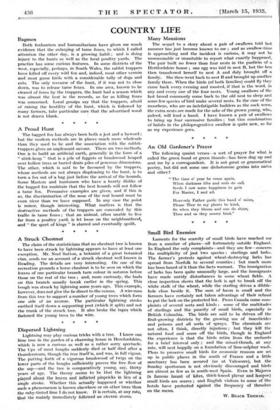Small Bird Enemies Laments for the scarcity of small birds
have reached me from a number of. places—all fortunately outside England. In England the only complaints--and they are few—concern the multiplicity of just two species : starlings and larks. The farmer's protests against wheat-destroying larks has spread from Norfolk to several counties ; but much more has been heard of it than the facts warrant. The immigration of larks has been quite unusually large, and the immigrants have made untidy disturbances in some wheat fields. A close inspection shows that the lark is apt to break off the white stalk of the wheat, while the starling drives a dibble- hole close beside it. The sum of harm is small and the farmers have certainly not taken advantage of their refusal to put the lark on the protected list. From Canada come com- plaints of several sorts and kinds : some of the multitudes of starlings and the paucity of small birds, especially in British Columbia. The birds are said to be driven off the fruit-growing districts by the growing use of insecticides and poisons and all sorts of sprays. The chemicals are not often, I think, directly injurious ; but they kill the natural food and scare off the birds, though in England the experience is that the birds retire from the orchards for a brief interval only ; and the rnissel-thrush, at any rate, will nest happily on a foundation of lime-sulphur wash. Pleas to preserve small birds for economic reasons are set up in public places in the south of France and a little sanctuary has been secured (as at Valescure), but the Sunday sportsman is not obviously discouraged and birds are almost as few as in south-west Spain. Even in Majorca (a famous haunt of kites, thick-kneed plover and hoopoe) small birds are scarce ; and English visitors to some of the hotels have protested against the frequency of thrushes on the menu.
W. BEACH Thomas.










































 Previous page
Previous page